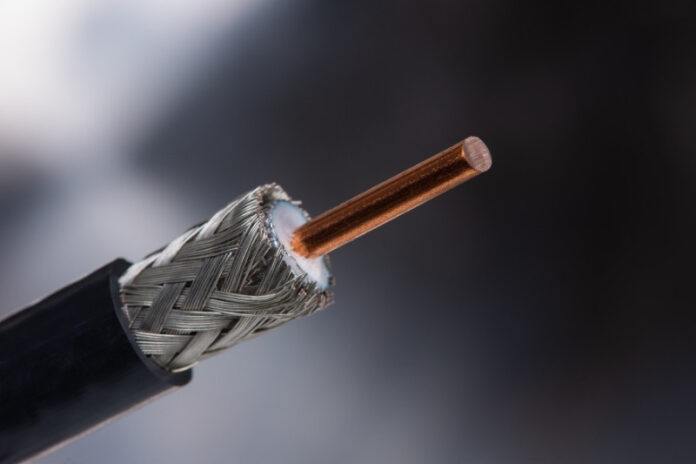Coaxial speakers (also called coax cables) are electrical wires capable of transmitting RF (Radio Frequency) data from an energy source in a device via its coaxial connector. The frequency of RF signals will encompass the upper range of the spectrum audio and the lower frequency of the infrared spectrum.
It translates into an amplitude between 20kHz and 300GHz. The cable first came out in 1858. The cable has been among the most used wires in every home since the beginning of the century, particularly with the advent of televisions.
The coaxial cable consists of an inside conductor surrounded by a tubular insulation layer generally made up of a flexible substance with a highly-conductive outer braid or shield.
Coaxial cables are employed in various applications, including audio and video communication, network connectivity for computers, and transmitting data from one device to another. They also provide power to specific applications.
Uses of Coaxial Speaker Cable
Coaxial cables are primarily used to send videos and audio signals. In many instances, they are incorporated into complicated video distribution and relay systems, but most of us never see these cables. The most popular cables used in video applications includes:
- RG59/U is primarily employed to transfer HD video signals at small distances.
- It is the primary coax for connecting cable television and the internet in our offices and homes.
- The RG11/U is similar to the RG6/U, but it’s more robust and has less signal loss. These kinds are ideal for transmitting signals over long distances.
If you’re not an IT expert, you won’t notice most of the common kinds of coax available. They are also costly; therefore, we are more likely to come across RG6/U cables in our homes.
Components of a Coaxial Cable
The design that coaxial wires take is flat and cylindrical. They come in many different colours and thicknesses. Additionally, their designs could be simple or complex; however, they all have four fundamental elements, including:
- Core Conductor: Copper is the primary substance used in the production of the core. It is also possible to find a core made of copper-plated steel or stranded copper.
- Dielectric Insulator: The conductor surrounds the dielectric insulator at its core. The materials used for this component vary, including foam and solid plastic. Sometimes, manufacturers leave the space between the insulator and the core empty.
- Metallic shield: Cables with higher ratings can include two shields: aluminum foil and twisting copper wire. Shielding could be as thick as four layers, containing two aluminum foils and two copper wires twisted. improves productivity and reduces losses.
- Plastic Jacket: The last cable layer is the outer layer, mainly PVC (Polyvinyl Chloride). Sometimes, it’s even water-resistant according to the purpose.
Types Of Connectors Used For Coaxial Cables
Coaxial cable connections make connecting the cables to other gadgets simpler. They can also keep the speaker cord protected. Additionally, you’ll notice that the best connectors provide durable, long-lasting connections. Here are a few types of speaker cables that are coaxial:
- SMA: The SMA (also known as the SubMiniature version) is the largest and most well-known connector for RF use. The SMA connection can handle the widest range of frequencies, ranging from zero Hz to 12GHz.
- BNC: Bayonet Neil-Concelman connectors can be described as tiny to medium-sized RF connectors. It can connect and unplug TVs and Radios, radio equipment, test instruments, and other devices.
- TNC: Threaded Neil-Concelman is a threaded variation from BNC connectors. In contrast to BNC connectors, these generally operate at higher microwave frequencies.
- SMB: Subminiature version B is the smaller version of SMA connectors. They’re well-known for their extraordinary electronic properties that range from DC to GHz.
- QMA: QMA connections share the same internal design as SMB. These connections, however, permit more rapid closing and detaching.
- 7/16 DIN: Deutsches Institut fur Normung connections are RF connections that have threads and are ideal for high-wattage information transmission.
- RCA: Cinch connections are an alternative name for those that belong to RCA (Radio Corporation of America). They utilize cables made of red, yellow, and white wires that connect to the rear of televisions.
- MCX: The micro coaxial connectors can be described as small connections. They’re perfect for applications with small dimensions, weights, or space. MCX can work with 6GHz or DC in GPS, TV tuner wireless hardware, and a few mobile applications for phones.
Benefits and drawbacks of Coaxial Speaker Cable
Advantages:
- Durability: Coaxial cables are highly robust and are immune to physical damage. It makes them ideal for installations that last a long time.
- Low Cost: The coaxial speakers are cheap compared to other cables. Because of this, they are great for people on a tight budget.
- Easy to Install: Coaxial cables are straightforward to install and require only tools. It makes them a great option when it comes to DIY projects.
- Multi-purpose: The Coaxial speakers are available in various lengths and styles, which can be helpful in many different applications.
Disadvantages
- Expensive: Coaxial speakers cost more than conventional speaker wires. This makes it a more expensive option for budget-conscious consumers.
- Heavy: They’re heavier than standard speaker wires, making them more difficult to install.
- Impedance matching: Coaxial cables need impedance matching to guarantee proper audio quality. For first-time users, this can be hard.
- Loss of Signal: Cables are affected by signal losses over long distances. It results in poorer sound quality.
How to Connect Speaker Wire With Coax Cable?
Using coax as an audio cable could be more efficient. The amp’s Impedance load is a problem in using coax for a speaker, and it won’t be driven as hard due to the more excellent resistance of the setup. The risk of damaging the entire system can yield results. The more distance between you and cable, the higher the risk.
However, your system’s wiring may need to produce the sound quality you’d hoped for, but you could use a coax cable if you don’t have any alternative. Making sure your equipment is near the cable coaxial is the best method to reduce the chance of. Additionally, you’ll get a more sound-producing routing experience when you keep items in the kHz frequency range.
Conclusion
After reading this blog, you’ll be able to utilize your coaxial cable and audio wire without any limitations. With the wide selection of premium speaker wires available on the marketplace, it may make sense to change your coaxial cable to speaker wire.
The choice of whether or not to change the coaxial cable into a speaker wire is yours to decide. If you choose to use coaxial cables as speaker cord, look for a variety that has greater flexibility, also known as versatile coax cables. There are a variety of choices for that type of coax cable available.
Read Also : JBL Boombox 2 and JBL Xtreme 3: Essential Aspects Compared





































































